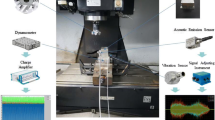Abstract
The prediction of continuous tool wear process plays an important role in realizing adaptive control and optimizing manufacturing process so as to improve production efficiency and quality of the workpiece. However, the complexity of the tool wear process and the unpredictable disturbance during milling process make it difficult to realize robust and accurate estimation of the tool wear value. In this paper, the Gaussian mixture regression (GMR) model is proposed to realize continuous tool wear prediction based on features extracted from cutting force signal. The main characteristic of the GMR model is that the relationship between the tool wear value and the features is built by the combination of the Gaussian mixture model in which the variation of the training data is described by the probability density of the Gaussian distribution, and the wild data can be abandoned if its probability is small enough. To test the effectiveness of the proposed method, the experiment of titanium alloy milling was carried out, and the spectrum peak value corresponding to the harmonic of tooth passing frequency was extracted as the explanatory variables to predict the tool wear value. In addition, multiple linear regression, radius basis function, and back propagation neural network are also adopted to make a comparison with the GMR model. The analysis of four performance criteria shows that the GMR-based method is the most accurate among these methods.
Similar content being viewed by others
References
Venkatesh K, Zhou M, Caudill RJ (1997) Design of artificial neural networks for tool wear monitoring. J Intell Manuf 8:215–226
Brezak D, Majetic D, Udiljak T, Kasac J (2012) Tool wear estimation using an analytic fuzzy classifier and support vector machines. J Intell Manuf 23:797–809
Silva RG, Reuben RL, Baker KJ, Wilcox SJ (1998) Tool wear monitoring of turning operations by neural network and expert system classification of a feature set generated from multiple sensors. Mechanical Systems and Signal Processing 12:319–332
Liu Q, Altintas Y (1999) On-line monitoring of flank wear in turning with multilayered feed-forward neural network. Int J Mach Tool Manuf 39:1945–1959
Yao YX, Li XL, Yuan ZJ (1999) Tool wear detection with fuzzy classification and wavelet fuzzy neural network. Int J Mach Tool Manuf 39:1525–1538
Kuo RJ, Cohen PH (1999) Multi-sensor integration for on-line tool wear estimation through radial basis function networks and fuzzy neural network. Neural Networks 12:355–370
Chen JC, Chen JC (2004) A multiple-regression model for monitoring tool wear with a dynamometer in milling operations. J Technol Stud 30:71–77
Li X, Zeng H, Zhou JH, Huang S, Thoe TB, Shaw KC, Lim BS (2007) Multi-modal sensing and correlation modelling for condition-based monitoring in milling machine. SIMTech technical reports 8:50–56
Bhattacharyya P, Senguptaa D, Mukhopadhyay S (2007) Cutting force-based real-time estimation of tool wear in face milling using a combination of signal processing techniques. Mechanical Systems and Signal Processing 21:2665–2683
Sung HG (2004) Gaussian mixture regression and classification. Dissertation, Rice University
Falk TH, Shatkay H, Chan WY (2006) Breast cancer prognosis via Gaussian mixture regression. Canadian conference on Electrical and Computer Engineering, Ottawa, pp 987–990
Calinon S, D'halluin F, Sauser EL, Caldwell DG, Billard AG (2010) Learning and reproduction of gestures by imitation. IEEE Robot Autom Mag 17:44–54
Cederborg T, Li M, Baranes A, Oudeyer PY (2010) Incremental local online Gaussian mixture regression for imitation learning of multiple tasks. IEEE/RSJ International Conference on Intelligent Robots and Systems, Taipei, pp 267–274
Tian Y, Sigal L, Badino H, Torre FDL, Liu Y (2010) Latent Gaussian mixture regression for human pose estimation. 10th Asian Conference on Computer Vision, Queenstown, New Zealand, 679–690
Guo P, Lyu MR (2000) Software quality prediction using mixture models with EM algorithm. The First Asia-Pacific Conference on Quality Software, Hong Kong, China, 69–78
Zhang S, Li JF, Sun J, Jiang F (2010) Tool wear and cutting forces variation in high-speed end-milling Ti-6Al-4V alloy. Int J Adv Manuf Technol 46:69–78
Yan W, Wong YS, Lee KS, Ning T (1999) An investigation of indices based on milling force for tool wear in milling. J Mater Process Technol 89–90:245–253
Susanto V, Chen JC (2003) Fuzzy logic based in-process tool-wear monitoring system in face milling operations. Int J Adv Manuf Technol 3:186–192
Kious M, Ouahabi A, Boudraa M, Serra R, Cheknane A (2010) Detection process approach of tool wear in high speed milling. Measurement 43:1439–1446
Huang P, Li J, Sun J, Zhou J (2012) Vibration analysis in milling titanium alloy based on signal processing of cutting force. Int J Adv Manuf Technol. doi:10.1007/s00170-012-4039-x
Cheryl R, Errol Y (2008) “Hits” (not “discussion posts”) predict student success in online courses: a double cross-validation study. Comput Educ 50:1174–1182
Author information
Authors and Affiliations
Corresponding author
Rights and permissions
About this article
Cite this article
Wang, G., Qian, L. & Guo, Z. Continuous tool wear prediction based on Gaussian mixture regression model. Int J Adv Manuf Technol 66, 1921–1929 (2013). https://doi.org/10.1007/s00170-012-4470-z
Received:
Accepted:
Published:
Issue Date:
DOI: https://doi.org/10.1007/s00170-012-4470-z




